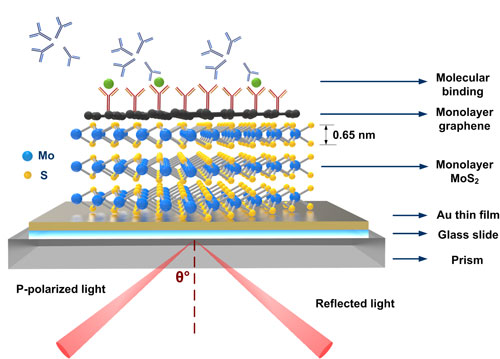| Posted: Sep 11, 2015 |
Transition metal dichalcogenide plasmonic biosensors
(Nanowerk News) Graphene is well-known as the thinnest two-dimensional (2D) material in the world. Since its first discovery in 2004 by Andre Geim and Kostya Novoselov, many of its unique optical and electronic properties have been explored (e.g., zero bandgap with high electrical conductivity and zero effective mass at the Dirac point).
|
|
The high charge carrier mobility of graphene (106 cm2 V-1 s-1) makes it an attractive sensing substrate for surface plasmon resonance (SPR) sensors.
|
|
SPR sensors are one of the most commonly used optical sensors for real-time monitoring of biomolecular interactions. By coating graphene layers on the metallic SPR sensing substrate, strong electric field enhancement at the metal/graphene interface can be achieved which is due to the effective charge transfer between the two materials.
|
|
However, the absorption rate of monolayer graphene is determined to be 2.3% and this prevents the successful of light transfer to plasmon resonance. Thus, it is very challenging to engineer an ultrasensitive SPR sensor that is capable of detecting markers with molecular weight less than 400 Da.
|
|
Recently, transition metal dichalcogenide (TMDC) nanomaterials, especially molybdenum disulfide (MoS2), have emerged as an attractive complementary 2D nanomaterial to existing graphene system. Monolayer MoS2 has not only a higher absorption rate (~5%) than graphene, but also has a lower electron energy loss.
|
 |
| (click on image to enlarge)
|
|
In this investigation led by Dr. Zeng Shuwen and Prof. Yong Ken Tye, a novel SPR sensing configuration using graphene-MoS2 hybrid structures was proposed to overcome the challenges mentioned above ("Graphene–MoS2 hybrid nanostructures enhanced surface plasmon resonance biosensors").
|
|
A 500-fold enhancement in the phase-sensitivity has been achieved by using the hybrid structure system when compared to that without the graphene-MoS2 coating.
|
|
These finding shows that the best sensitivity limit was achieved by employing 3 monolayers of MoS2 and 45 nm of Au thin film thickness.
|
|
Currently, Dr. Zeng and Prof. Yong are researching new approaches for preparing biofunctionalized graphene-MoS2 layers where they can be utilized for public healthcare and environmental monitoring (e.g. cancer biomarkers and environmental pollutants detection).
|

